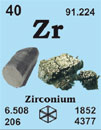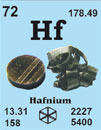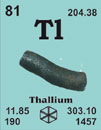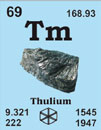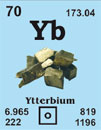Zinn 50Sn118.69
In alten Kulturen bekannt.
[Angelsächsich, tin; Lateinisch, stannum]
French: etain
English: tin
Italian: stagno
Spanish: estaño
Beschreibung: Weiches, geschmeidiges, silberweißes Metall. Reagiert nicht mit Sauerstoff (passiviert durch eine Oxidhaut) und Wasser, aber löst sich in Säuren und Basen. Verwendung: Weichlote, Legierungen, Verzinnen für Polymere, Antifoulingmittel für Farben.
Zinn single crystal properties
| State: |
single crystal |
|---|
| Crystal structure: |
tetragonal |
|---|
| Production method: |
Bridgeman |
|---|
| Standard size: |
diameter 9-10mm
thickness 1-2mm |
|---|
| Orientation: |
(100), (110) and (111) |
|---|
| Orientation accuracy: |
<2°, <1°, <0.4° or <0.1° |
|---|
| Polishing: |
as cut, one or two sides polished |
|---|
| Roughness of surface: |
<0.03µm |
|---|
| Purity: |
99.999% |
|---|
| Typical analysis (ppm): |
C 3
H < 1
O 9
N < 5
Cu 1.60
Fe 1.80
Ni < 1
Pb 0.30
Si 0.30
Ga, Hf and Ta are below the detection limit
|
|---|
Materials properties
| Density: |
7.30 g/cm3 |
|---|
| Melting point: |
231.968 °C / 505.118 °K |
|---|
| Boiling point: |
2269.85 °C / 2543 °K |
|---|
| Molar volume: |
16.24 (b) cm3 |
|---|
| Thermal conductivity: |
66.6 (a) [300 K] Wm-1K-1 |
|---|
| Coefficient of linear thermal expansion: |
5.3 x 10-6 (a) K-1 |
|---|
| Electrical resistivity: |
11.0x 10-8 (a) [273 K] Wm |
|---|
| Mass magnetic susceptibility: |
-4.0 x 10-9(a) kg-1m3 |
|---|
| Young's modulus: |
49.9 GPa |
|---|
| Rigidity modulus: |
18.4 GPa |
|---|
| Bulk modulus: |
58.2 GPa |
|---|
| Poisson's ratio: |
0.357 GPa |
|---|
| Radii: |
Sn4+ 74; Sn2+ 93; Sn4- 294; atomic 141; covalent 1 |
|---|
| Electronegativity: |
1.96 (Pauling); 1.72 (Allred); 4.30 eV (absolute) |
|---|
| Effective nuclear charge: |
5.65 (Slater); 9.10 (Clementi); 11.11 (Froese-Fischer) |
|---|
| Number of Isotopes (incl. nuclear isomers): |
37 |
|---|
| Issotope mass range: |
106 -> 132 |
|---|
| Crystal structure, (cell dimentions / pm), space group |
tetragonal |
|---|
| X-ray diffraction: mass absorption coefficients: |
CuKα 256 (µ/r) / cm2g-1
MoKα 31.1 (µ/r) / cm2g-1 |
|---|
| Neutron scattering length: |
0.6225 b/10-12 cm |
|---|
| Thermal neutron capture cross-section: |
0.626 sa / barns |
|---|
Biological data
| Biological role: |
May be essential to some organisms, including human. |
|---|
| Toxicity |
|
|---|
| Toxic intake: |
low toxicity as metal and some inorganic tin (II) salts |
|---|
| Lethal intake: |
LD50 (SnCl2, oral, rat) = 700 mg kg-1 |
|---|
| Hazards: |
Tin (II) salts can be pisonous by ingestion and other routes and there is evidence that tin can have experimental carcinogenic and human mutagenic effects. Some organotin compounds are very toxic. |
|---|
| Level in humans |
|
|---|
| Blood: |
c. 0.38 mg dm-3 |
|---|
| Bone: |
1.4 p.p.m. |
|---|
| Liver: |
0.23 - 2.3 p.p.m. |
|---|
| Muscle: |
0.33 - 2.4 p.p.m. |
|---|
| Daily dietary intake: |
0.2 - 3.5 mg |
|---|
| Total mass of element in average [70 kg] person: |
20 mg |
|---|
Geological data
| Mineral | Formula | Density | Hardness | Crystal apperance |
|---|
| Cassiterite |
SnO2 |
6.99 |
6 - 7 |
tet., adam./ met. brown |
|---|
| Chief ore: |
cassiterite |
|---|
| World production: |
165 000 tonnes/year |
|---|
| Main mining areas: |
Malaysia, Sumatra, Russia, China, Bolivia, Zaire |
|---|
| Reserves: |
4.5 x 106 tonnes |
|---|
| Specimen: |
available as bars, breads, foil, granules, rod, shot and wire. Safe. |
|---|
| Abundances |
|
|---|
| Sun: |
100 (relative to H = 1 x 1012) |
|---|
| Earth's crust: |
2.2 p.p.m. |
|---|
| Seawater: |
|
|---|
| Residence time: |
|
|---|
| Classification: |
scavenged |
|---|
| Oxidation state: |
IV |
|---|

 English
English
 Deutsch
Deutsch








































